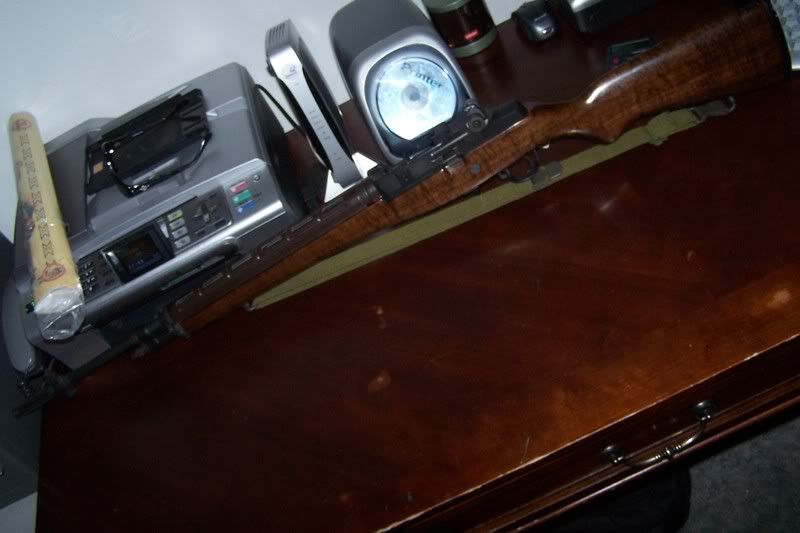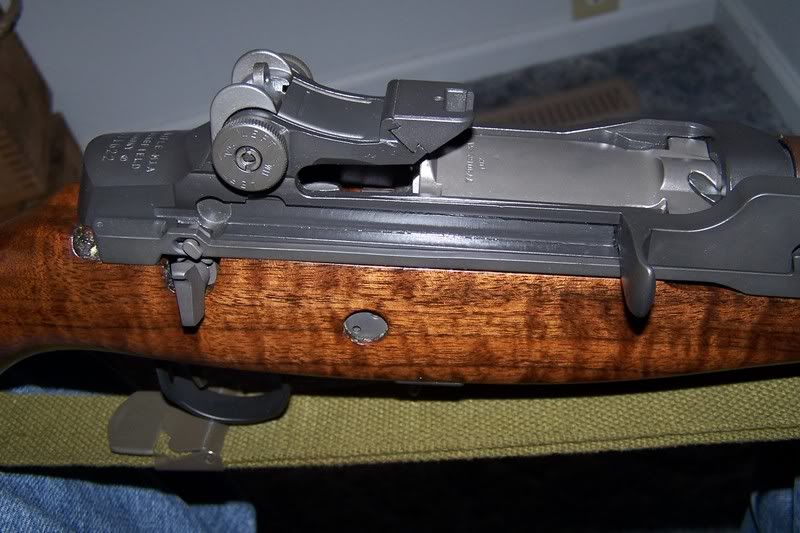Re: M14/M1A stock question.
GI Stocks almost unfailingly have several ordnance markings, usually on the left side near and ahead of the grip.
From an old article I once wrote...
A New Finish for that Old GI Stock
Oboy! You just got that long rectangular box delivered by parcel post, with the DCM return address, and you just can’t get those salivary glands to stop gushin’. You open it up and it’s not exactly brandy new, but what the heck, that’s just the character showing, is all... Right...!
You’ve fallen back into love with an old flame, an M1 Garand. You are beginning to hedge your bets and maybe start to admit that Uncle Sam can maybe get one thing right, at least. You’ll never part with it, you’ll never do anything to the metal, (you wouldn’t know where to start, anyway), but the stock... Well maybe it’s got just a little too much character. Yeah, the stock... It needs a little help. Yeah, that’s it, the stock... Maybe a new finish. I’m just not sure I know how to go about it right.
Here I come to save the day!, Mighty Mouse (or maybe yours truly) is on the way, etc.!!!
The wood in almost any GI stock is really gorgeous material, if it’s just given a chance to show its stuff. Most DCM stocks show the effects of several periods of issue to line troops, with a ding here, a scratch there, and lots of coats of Oil, Preservative, Wood, Raw Linseed. It’s that chocolate brown GI wood color. You know there’s a beautiful hunk of walnut, with some pretty grain down under all that old gunk and dirt. But for now, you just have to take that all on faith.
I’ve read a lot of articles on finishing in general, and firearms in particular. I built all those balsa wood flying models and used to put a really neat finish on them with that Aero Gloss lacquer dope; and the wife made me refinish a lot of old furniture, too. But I never got up enough guts to take on one of my rifle stocks.
Lets cut to 1995. It’s May 22, my 49th birthday, and the doorbell rings. It’s The Postal Dude, and he’s carryin’ a gun... DUCK!!! Wait a minute, that’s My gun, the DCM Garand, and he wants me to sign for it. Reread the first two paragraphs. You get the idea. It’s guts time in the Langelius household. Time to make the donuts.
Lets consider linseed oil. There’s a ton of it already on the stock. Its just old and dried up, and full of grime from all those low crawls and vertical butt strokes we all delivered in training. Actually, linseed oil is pretty good stuff for what Uncle Sam makes us use it for, preserving rifle stocks. It’s just that combat is no place for a shiny stock, and Uncle Sam makes sure he never gives us anything to put on the wood that’s gonna make it SHINE! Otherwise, its an excellent wood preservative, and we’re gonna use it as part of the refinishing process, but more on that later. It’s also the basic component of most high quality oil base paints. It comes in a lot of forms. Most of them are either raw or boiled. Sometimes it’s used as part of a blend. There are also other finishing oils like Tung oil, and the like. The best oil finish blend I’ve tried so far is Birchwood Casey’s Tru-Oil, and that’s what I’m going to tell you how to use. I refinish several stocks a year, usually for friends, and that’s all I ever use anymore.
You’re also going to need some other materials, and just how much of each item is governed by just how much energy you plan on investing, and just how magnificent a finishing job you have in mind (or just how badly obsessed you’re behaving today).
The key to finishing is the smoothness of the wood/oil finish combination. Smoothness is achieved with copious application of elbow grease, sandpaper, and steel wool. The sandpaper should be wet-or-dry, and in grades ranging from 320 to 600; anything finer than that and you’re really in need of a Shrink. Besides, that’s what we use steel wool for. In fact, you may end up not using the sandpaper, at all; it all depends on just how coarse the grain is on your wood, and how much it needs filling. The steel wool should be several grades. We’ll need coarse grade for stripping off the paint stripper. The final smoothing and sanding will require 00 and 0000 or 00000 grades, whatever your degree of patience will accommodate. Don’t be afraid to buy too much, there’s no such thing.
Also get some gel-type paint stripper, some paint thinner, and optionally, small quantities of wood alcohol and lacquer thinner. Buy some cheap, disposable, 1 inch NATURAL BRISTLE brushes, 2 or 3 of them. Get some Masking Tape, 1/2 or 3/4 inch, whatever’s available, but try to make sure its fresh. Old masking tape can be hard to remove. A few ounces of linseed oil, boiled, and a small bottle or two of Birchwood Casey’s Tru-Oil will finish up the list. You can get everything but the Tru-Oil from your local hardware purveyor, the Tru-Oil can be obtained at most Gun Stores. And Oh Yeah, don’t forget a BUNCH of paper towels, some old newspapers, and a couple of sturdy pairs of rubber gloves, we’ll need them when we use the paint stripper.
To make a nice new finish, we need to start from scratch, preferable with a new piece of wood or one that’s just like new. So.... Off with the old finish!
Remove all the easily removable hardware, like the buttplate and rear sling loop. The rest of the hardware will have to be covered with masking tape. Degrease the metal first, alcohol works fine for this. You can trim off any excess tape with a razor blade. Try to put on at least two layers.
Pick a place where you can make a world-class mess and leave it for a week or so without getting brained by the wife; this is REALLY IMPORTANT!! Spread out a couple of layers of old newsprint over your work area (you’ll thank yourself, and maybe me too, later). Put on the rubber gloves, open the paint stripper, and pour some into an old, clean, I repeat, CLEAN, soft plastic cup. I prefer old margarine tubs. Be religious about doing whatever it takes to keep the paint stripper separate from your eyeballs, you’re gonna need them to shoot this thing, later. Take one of the 1 inch brushes, and liberally apply the paint stripper gel to the entire stock, inside and out. Put the stuff everywhere you can reach. Follow the can instructions concerning waiting, and putting on additional coats. Strip the stripper off with the coarse steel wool. Do the whole procedure 2 or 3 times, taking particular care to clean out any dents and recesses, and NOT to wear down the sharp edges with the steel wool.
When you’re convinced that only God could get the wood any cleaner, pick up the old newspaper and throw it out, along with the plastic cup and the 1 inch brush you used. Spread out a new coat of newspaper and mix up some paint thinner, lacquer thinner, and wood alcohol in another plastic cup. By now you have probably learned that styrene cups will just melt, so don’t use them. Open all the windows. Wad up a ball of paper towel and saturate it with the mixture. Bathe the stock in it. The object is to remove all traces of paint stripper from the wood. It would only weaken the foundation we’re going to build. When you’re convinced that only God, etc., put the stock aside and let it dry out for at least 24 hours. Throw out the cup and any remaining mixture.
There are two type of finishes; sealing, and non-sealing. The difference is whether moisture (water) can pass through the finish. Linseed oil is not a sealer. Tru-Oil is. Another difference between finishes is whether or not it is repairable. A non-repairable finish must be removed from the entire piece and replaced, it cannot be spot-repaired. Urethane is non-repairable. Lacquers and enamels might be repairable, probably not. Linseed oil and Tru-Oil are repairable, and can even be combined.
This is the point where we consider repairing the dents and dings. Some of the real monsters are immortal. We can’t fill anything much bigger than 1/4 inch across. For something like that, consider using a quality wood filler putty. Or not, remember the character bit. For the non-ferocious dents and dings, steam is the answer, along with some courage. Take out that paper towel and soak it in water, maybe a little alcohol, too. Place a wet compress over the dents and soak them thoroughly. Keep the area wet for as long as it takes to convince yourself that you’re never going to get it any wetter.
Now, borrow your wife’s steam iron. I promise you that you can promise her it’ll not get wrecked. Set it for steam and the hottest temperature setting. Lift up the compress, replace it with a single layer of dry paper towel, and press the iron down over it. Watch out for the steam, it’s really hot. Take peeks at the wood every few seconds to make sure you’re not burning it. Stop when the wood is dried or you run out of courage.
If you’re going to have any effect, you will be seeing it by now. What is happening is a minor miracle. When wood gets dented, the fibers get bent and crushed together. The natural resin, called lignin, is sheared away from the fibers and the wood is weakened. When we soak the wood, the fibers swell. When we apply the heat, the water turns to steam and reinflates the fibers, swelling them further. Additionally, the lignin is melted down and reglues the fibers back together. In effect we are actually repairing the original damage.
You can repeat the process, but the additional effect is less each time you do it. Eventually you will quit. If the wood is not completely restored, some careful sanding, using a block or a stiff pad, will probably complete the job. Incidentally, lignin can also be dissolved in certain substances, including ammonia, and this can aid the fixing task. But be careful, ammonia is also a bleach, and can stain the wood. You may also wish to beach and/or stain the stock. Now is the time for that. If you do, be sure to use products specifically designed for wood finishing uses, and follow all directions and safety precautions. Wood bleach can be pretty deadly stuff..
When you plan to apply a sealing finish, you need to bear in mind that once it’s on, that’s it. Nothing can pass through it, either inbound or outbound. Most wood is actually very dry when you get it. After stripping and bathing your stock in the solvent mixture, your stock is as dry as a cork. This robs the wood of its strength and resiliency. It’s often best to treat things like wood and leather as if they were still living things, and consider feeding them a healthy diet. Your stock needs a nourishing drink before you seal it off from the outside world forever, and we want it to drink deep. We need to give it something that will penetrate the wood as deep as possible. We’re gonna do a trick here.
Pour some boiled linseed oil into another one of those plastic cups, and some paint thinner into another one. Take a fresh 1 inch brush and coat the stock with the linseed oil, everywhere, inside and out. Really saturate it. Wait five minutes. Take a bunch of paper towels and rub the stock down completely, until it is bone dry. Take the brush and coat the stock with paint thinner. Soak it good. Wait five minutes. Wipe the stock down again with paper towels, until it’s bone dry again. What we have done is load the stock up with all the linseed oil it can take, and then driven it down into the wood as far as possible with the thinner. Put away the thinner and never bring it near that stock ever again. Put the stock away and let it dry completely.
When you’re satisfied that the first coat is really dry, saturate the stock again with linseed oil, wait five, and bone dry it again. Let it dry overnight again. Don’t try to rush this. What you are doing is giving your wood its best chance at immortality, before it gets sealed til doomsday.
You can repeat the linseed oil step as many times as your patience will allow, but two coats is probably optimal. Save the linseed oil for other stocks, or this one, if you’re going for what I call a “Service Rifle” finish.
It’s now time for the Tru-Oil. Tru-Oil can be applied several ways. It can be brushed on, rubbed on, and even comes in a spray can. I don’t use the spray, it’s a real mess. When brushing, use a brush that doesn’t shed. When rubbing, use a cloth that is definitely lint-free. Use either method, but keep two things in mind. Thin coats are better than heavy ones, especially the last few coats. The other thing is that Tru-Oil dries fast and gets tacky in only a minute or two. It dries fast, but takes a few hours to harden. Trying to apply additional coats too soon will only soften the lower layers, making a mess and weakening the final finish. If you goof, don’t panic. First thing, let the finish harden completely. Second, don’t worry, you’re going to cut it all back to the grain anyway, so no real damage is done. Actually, the only thing that happens when you rush the coats is that you just increase the hardening time.
Start by applying 3 or 4 coats, inside and out, allowing each coat to dry fully. It will start to look glossy but grainy. Stop and let everything harden really good.
You might be tempted to quit at this point, after all, it’s nice and shiny, and hard. It’s probably sealed OK, too. It’s just not very smooth. If you bail out now, I’ll never tell, but in your heart of hearts, You’ll know.
What we want to do now is cut the high spots down to the level of the low grain lines.
Take part of a 00 steel wool pad and start rubbing. Rub everything on the outside, the inside only needs to be smoothed by those with a certifiable obsession. Keep rubbing, until you cut the finish all the way back down to the wood. The shine is gone, but the grain is filling up. You will probably start to hate me by now, because your arm is all cramped up, and the exercise is starting to make you look warped, all huge on one side and wimpy on the other. Sorry, can’t help that. Consider becoming truly ambidextrous.
You will probably be wondering by now just when we use the sandpaper. Sandpaper is a shortcut to filling really coarse grain. If the grain looks like cornrows, or there are some pretty nasty dings, it’s time to break out the 320. We are going to use an old cabinet finisher’s trick. We are going to use a powder to fill the grain. The best powder is one that matches the color and texture of the actual wood. The best binder for the filler powder is one that has a consistency similar to the actual finish. The best powder is a fine sawdust cut from the actual stock wood. The best binder is the finish oil. The way to do this trick is to put a good wet spot of Tru-Oil over the area to be filled, and start sanding in a circular motion right over the area we want to fill. Stick to one small area at a time. As the sandpaper cuts the wood, a paste will form. Keep adding a small bit of Tru-Oil, keeping the area wet. After a while, a muddy goopy mess will form. Start moving over a little bit at a time, leaving a trail of mud behind. Eventually, there will be a muddy coating over the grainy area. So it looks ugly, so what. Resist all temptation to wipe off that gooey mess. If you do anything, try to spread it out nice and even. Put that baby away until it’s good and dry and hard.
Take out the 600 grit and dry sand the stock down to the wood again. Keep working, until you like what you see. When the stock is smooth and even, the filling is done. Let it dry good and hard.
If the grain is fine and tight, you can probably skip the sand and fill process.
Continue with the build up, cut down with steel wool process. Usually, two or three times is plenty. Make sure that you cut the finish all the way down to the grain each time. Wipe the stock down with a soft cloth and hold it up to the light. Look carefully at the reflection. You will eventually be able to distinguish between areas where the grain is filled and where it is not. When all the grain is filled, stop and wipe the stock down carefully, getting rid of every speck of dust.
We have reached a decision point. We need to understand that a finish consists of two steps, the fill and the shine. We have completed the fill step. The protective part of the finish is done, the stock is sealed.
The shine step is a matter of choice. Some like ‘em glossy, some don’t. Most beginners like to get ‘em shiny enough to knock yer eye out, mostly just to prove they can do it. They even like to make the finish deeeeep, like it was dipped in glass. All this is fine. That’s what my first stock looks like, and I’m still proud as punch about it. This sort of finish looks best on a custom target rifle, or a hunter. Many service rifles sport this kind of finish, and they are real beauties. They can also be real headaches. A service rifle is most likely to be used in service type competitions, and highpower matches. A finish can take a real beating, and keeping that gleamer gleaming can be a lot of work. Also, some folks like that service rifle to have a satiny, silky finish, instead of the gleam. It’s more authentic. A shiny rifle can attract the kind of attention in combat that like to get a man killed, get my drift? The satiny, silky finish is what I call a “Service Rifle” finish.
If the satin look is your goal, you’re done. To maintain this finish, just apply a coat of boiled linseed oil whenever you’re done cleaning the rifle, wiping any excess off after waiting five minutes. Polishing with the dry palm of the hand will keep this finish gorgeous.
If a gloss is your goal, apply any additional coats by rubbing, keeping the coats real thin. If the fill was done right, it only takes a very little additional oil to put on a really beautiful shine. Use the 0000 or 00000 grade steel wool every 2 or 3 coats, but don’t take it down to the wood anymore. Just gently knock the shine off, to provide a little “tooth” for the succeeding coats to bind to. When you’ve got it where you like it, knock down the shine one more time, and apply a slightly heavier coat. Let it dry real hard, and polish it up with a soft, dry cloth. To maintain this finish, use a wax preparation, like furniture polish. I like to use Birchwood Casey’s Wax, because I’m sure it’s compatible with my finish. You can also use car wax. Whatever you use, stay away from preparations containing silicone. Silicone penetrates the finish, any finish, right down to the wood. This weakens the finish’s bond with the wood, eventually causing cracks and blisters. Additionally, no new finish material will stick to the silicone, which has, by now, penetrated the wood. Silicone will gradually screw up the finish and also make it impossible to repair. Avoid it like the plague. Overspray from WD-40 on the metal parts will do the same thing. I don’t use it. Ever. Incidentally, the same thing happens with car paint. That’s why body shops insist on refinishing entire body panels. It all has to be removed, including the top surface of the metal, itself. I hate silicone.
You can make some beautiful music with a wood finish, and this is only one way to do it. Other fine methods exist, and are probably worth looking into. I like my method because it uses mostly natural materials, and is all done by hand. It helps me form the bond with my possessions, putting a little bit of me in each of them. I like that idea.
Greg Langelius
If you want to glassbed it, I have an article on that, too.
Greg









